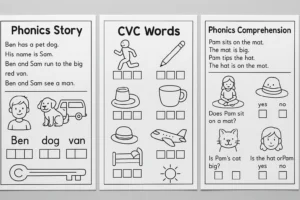
Source: freepik
Tenses Rules give clarity to communicating and writing in English. Tenses help us indicate when an action occurs—whether it’s in the past, present, or future. Learning the basic Tenses Rules can make communication clearer and more accurate. In this blog, we’ll explore the simple Tenses Rules that guide how verbs change based on time and how you can apply them in everyday situations.
Our comprehensive Grammar Course for Teachers brochure is, Available Here.
Enquire now for Grammar Course for Teachers via Call / Whatsapp on +918104606573 / +919869866277.
Rules for Tenses in Grammar with Examples
The timing of activities—whether they happened in the past, is still happening, or will take place in the future can be analysed using Tenses. The Tenses Rules in English are grouped into three major forms: Past, Present, and Future, each having four sub-groups.
Below is a clear explanation of Rules for Tenses in Grammar with Examples:
Past Tense
Used to describe events that happened and were completed in the past.
Simple Past Tense
- Rule: Subject + past form of the verb + object
- Meaning: Shows completed actions or events in the past
Examples:
- I placed a bucket under the table.
- She picked a flower from Nehru garden.
- We picked up food on the way to class.
Past Perfect Tense
- Rule: Subject + had + past participle + object
- Meaning: Describes an action that was completed before another past action
Examples:
- He had arrived at the party before sunset.
- She had gone to the office long before I reached.
- They had not been married long when Tom was born.
Past Continuous Tense
- Rule: Subject + was/were + verb(-ing) + object
- Meaning: Depicts an ongoing action in the past, often interrupted
Examples:
- I was dancing at the beach.
- They were sitting on a tree.
- I was studying last night.
Past Perfect Continuous Tense
- Rule: Subject + had been + verb(-ing) + object
- Meaning: Describes an ongoing action that started in the past and continued up to another past point
Examples:
- We had been studying for three hours when Mother came home.
- She had been reading a book before she decided to turn into a writer.
- Had she been washing clothes all day?

Source: medium
Present Tense
Used to describe actions that are happening right now or happen regularly.
Simple Present Tense
- Rule: Subject + base form of the verb (add -s/-es for he/she/it)
- Meaning: Describes habitual or general truths
Examples:
- Birds fly in the sky.
- My mother is a doctor.
- She plays lawn tennis.
Present Perfect Tense
- Rule: Subject + has/have + past participle
- Meaning: Describes an action that kicked off in the past but has relevance to the present
Examples:
- She has not polished her shoes yet.
- Aditya has gone out to the market.
- I have done all my chores.
Present Continuous Tense
- Rule: Subject + am/is/are + verb(-ing)
- Meaning: Describes actions currently happening or ongoing
Examples:
- She is playing basketball.
- I’m learning English.
- Yashika is leaving for work.
Present Perfect Continuous Tense
- Rule: Subject + has/have been + verb(-ing)
- Meaning: Describes an action that began in the past and is still continuing
Examples:
- He has been toiling here since 2019.
- They have been employed as artists in the art gallery.
- It has been snowing for a week now.
Future Tense
Used to describe acts that will occur after the present time.
Simple Future Tense
- Rule: Subject + will + base form of the verb
- Meaning: Refers to actions that are expected to happen
Examples:
- She will be a doctor one day.
- I will finish my homework later.
- He will cook dinner tonight.
Future Perfect Tense
- Rule: Subject + will have + past participle
- Meaning: Describes an action that will be completed before a specific time in the future
Examples:
- I will have finished the meal before my sister gets home.
- They will have decorated the office by 10 am tomorrow.
- He will have gone to sleep by the time I start cooking.
Future Continuous Tense
- Rule: Subject + will be + verb(-ing)
- Meaning: Describes an ongoing or continuous action that will happen in the future
Examples:
- They will be coming to New York next week.
- He will be watching television in her dormitory.
- She will be writing an email to David on Wednesday.
Future Perfect Continuous Tense
- Rule: Subject + will have been + verb(-ing)
- Meaning: Describes an action that will continue up to a point in the future
Examples:
- Next year, I will be 48 years old.
- By 2029, I will have been living in New York for a decade.
- I will have been cooking a meal when you come back here.
Understanding these Tenses Rules is the key to mastering the language and expressing thoughts more explicitly. Whether speaking about something that happened, is happening, or will happen, knowing the right Tenses Rules makes all the difference.

Source: dreamstime
English Tenses Rules, though tricky, can be mastered with the correct approach and daily practice. Correct sentence structure and clear expression of time in writing and speech can be achieved by comprehending Tenses Rules in English. Whether you’re a learner or planning to teach grammar, understanding Tenses Rules is essential.
Here are some practical Tips and Techniques to Master English Tenses Rules:
Focus on One Tense at a Time
Moving between tenses can confuse learners. Focus on one tense—like Simple Present—before moving on to other types. Understand its formation and usage, and practice using it in different situations.
Create Visual Charts
Make a chart with columns for tense name, structure, usage, and examples. Visual aids help in remembering the differences between similar tenses, especially perfect and continuous forms.
Practice with Real-Life Sentences
Use examples from daily life to write sentences. This helps reinforce learning and makes it easier to recall.
Read and Listen Actively
Pay attention to how Tenses Rules are used in books, articles, and conversations. Listening to English shows or podcasts can train your ear to recognize tense patterns naturally.
Take Notes and Review
Keep a small notebook to jot down tricky Tenses Rules examples and review them regularly. Revisiting them often will help you spot and correct errors faster.
Use Grammar Apps and Tools
Apps like Grammarly or interactive websites offer quick corrections and explanations. These tools reinforce correct usage and help you learn through feedback.
Practice Speaking Regularly
Don’t just write—speak! While talking, use different tenses to convey past happenings, current routines, or prospective programs.
The way to acquire proficiency in Tenses Rules in English is through patience, repetition, and thoughtful strategies. For those looking to become confident in grammar or teach it to others, enrolling in a Grammar Teacher Training Course can offer organized learning and adept insights. Vidhyanidhi Education Society’s (Govt. Regd.) Grammar Teacher Training Course is a trusted choice for building both knowledge and confidence in grammar instruction.
Join Vidhyanidhi Education Society’s Grammar Course for Teachers and Teach with joy!
Enquire now for Grammar Course for Teachers via Call / Whatsapp on +918104606573 / +919869866277.
Our comprehensive Grammar Course for Teachers brochure is, Available Here.
FAQs
Are There Rules in Grammar?
Yes, grammar has rules that support sentence structure, word usage, and punctuation to ensure clear and accurate communication in English.
What is a Grammar Rule?
A grammar rule defines the format of words and phrases to form correct sentences in a particular language like English.
How to Study Grammar?
Study grammar by reading, practicing exercises, and joining courses like the one offered by Vidhyanidhi Education Society for better understanding.



